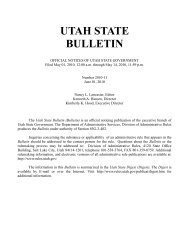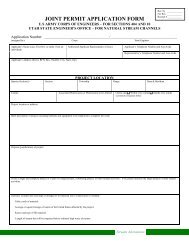Vol. 2007, No. 15 (08/01/2007) PDF - Administrative Rules - Utah.gov
Vol. 2007, No. 15 (08/01/2007) PDF - Administrative Rules - Utah.gov
Vol. 2007, No. 15 (08/01/2007) PDF - Administrative Rules - Utah.gov
Create successful ePaper yourself
Turn your PDF publications into a flip-book with our unique Google optimized e-Paper software.
NOTICES OF PROPOSED RULES DAR File <strong>No</strong>. 3<strong>01</strong>76<br />
COMMENTS BY THE DEPARTMENT HEAD ON THE FISCAL IMPACT THE<br />
RULE MAY HAVE ON BUSINESSES: Participation in the Quality<br />
Improvement Incentive Program is voluntary and will enhance<br />
the revenue of facilities that choose to participate. David N.<br />
Sundwall, MD, Executive Director<br />
THE FULL TEXT OF THIS RULE MAY BE INSPECTED, DURING REGULAR<br />
BUSINESS HOURS, AT:<br />
HEALTH<br />
HEALTH CARE FINANCING,<br />
COVERAGE AND REIMBURSEMENT POLICY<br />
CANNON HEALTH BLDG<br />
288 N 1460 W<br />
SALT LAKE CITY UT 84116-3231, or<br />
at the Division of <strong>Administrative</strong> <strong>Rules</strong>.<br />
DIRECT QUESTIONS REGARDING THIS RULE TO:<br />
Craig Devashrayee at the above address, by phone at 8<strong>01</strong>-<br />
538-6641, by FAX at 8<strong>01</strong>-538-6099, or by Internet E-mail at<br />
cdevashrayee@utah.<strong>gov</strong><br />
INTERESTED PERSONS MAY PRESENT THEIR VIEWS ON THIS RULE BY<br />
SUBMITTING WRITTEN COMMENTS TO THE ADDRESS ABOVE NO LATER<br />
THAN 5:00 PM on <strong>08</strong>/31/<strong>2007</strong>.<br />
THIS RULE MAY BECOME EFFECTIVE ON: 09/07/<strong>2007</strong><br />
AUTHORIZED BY: David N. Sundwall, Executive Director<br />
R414. Health, Health Care Financing, Coverage and<br />
Reimbursement Policy.<br />
R414-504. Nursing Facility Payments.<br />
R414-504-3. Principles of Facility Case Mix Rates and Other<br />
Payments.<br />
The following principles apply to the payment of freestanding and<br />
provider based nursing facilities for services rendered to nursing care<br />
level I, II, and III Medicaid patients, as defined in R414-502. This rule<br />
does not affect the system for reimbursement for intensive skilled<br />
Medicaid patient add-on amounts.<br />
(1) Approximately 59% of total payments in aggregate to nursing<br />
facilities for nursing care level I, II and III Medicaid patients are based<br />
on a prospective facility case mix rate. In addition, these facilities shall<br />
be paid a flat basic operating expense payment equal to approximately<br />
29% of the total payments. The balance of the total payments will be<br />
paid in aggregate to facilities as required by R414-504-3 based on other<br />
authorized factors, including property and behaviorally complex<br />
residents, in the proportion that the facility qualifies for the factor.<br />
(2) Each quarter, the Department shall calculate a new case mix<br />
index for each nursing facility. The case mix index is based on three<br />
months of MDS assessment data. The newly calculated case mix index<br />
is applied to a new rate at the beginning of a quarter according to the<br />
following schedule:<br />
(a) January, February and March MDS assessments are used for<br />
July 1 rates.<br />
(b) April, May and June MDS assessments are used for October 1<br />
rates.<br />
(c) July, August and September MDS assessments are used for<br />
January 1 rates.<br />
(d) October, <strong>No</strong>vember and December MDS assessments are<br />
used for April 1 rates.<br />
(3) MDS data is used in calculating each facility's case mix index.<br />
This information is submitted by each facility and, as such, each<br />
facility is responsible for the accuracy of its data. The Department may<br />
exclude inaccurate or incomplete MDS data from the calculation.<br />
(4) MDS assessments for recipients who are eligible for the<br />
"Intensive Skilled" add-on are excluded from the case mix calculation.<br />
A facility with less than 20 percent of its total census days as Medicaid<br />
days, as reported on its FCP or FRV data report, is excluded from the<br />
state case mix average. The state average case mix index is used to set<br />
the rate for that facility.<br />
(5) A facility may apply for a special add-on rate for behaviorally<br />
complex residents by filing a written request with the Division of<br />
Health Care Financing. The Department may approve an add-on rate if<br />
an assessment of the acuity and needs of the patient demonstrates that<br />
the facility is not adequately reimbursed by the RUGS score for that<br />
patient. The rate is added on for the specific resident's payment and is<br />
not subsumed as part of the facility case mix rate. <strong>Utah</strong>'s Bureau of<br />
Health Facility Licensure Certification and Resident Assessment will<br />
make the determination as to qualification for any additional payment.<br />
The Division of Health Care Financing shall determine the amount of<br />
any add-on.<br />
(6) Property costs are paid separately from the RUGS rate.<br />
(7) Property costs shall be calculated once per year, each July 1,<br />
and reimbursed as a component of the facility rate based on an FRV<br />
System.<br />
(a) Under this FRV system, the Department reimburses a facility<br />
based on the estimated current value of its capital assets in lieu of direct<br />
reimbursement for depreciation, amortization, interest, and rent or lease<br />
expenses. The FRV system establishes a nursing facility's bed value<br />
based on the age of the facility and total square footage.<br />
(i) The initial age of each nursing facility used in the FRV<br />
calculation is determined as of September <strong>15</strong>, 2004, using each<br />
facility's initial year of construction.<br />
(ii) The age of each facility is adjusted each July 1 to make the<br />
facility one year older.<br />
(iii) The age is reduced for replacements, major renovations, or<br />
additions placed into service since the facility was built, as reported on<br />
the FRV Data Report, provided there is sufficient documentation to<br />
support the historical changes.<br />
(A) If a facility adds new beds, these new beds are averaged into<br />
the age of the original beds to arrive at the facility's age.<br />
(B) If a facility completed a major renovation (defined as a<br />
project with capitalized cost equal to or greater than $500 per bed) or<br />
replacement project, the cost of the project is represented by an<br />
equivalent number of new beds.<br />
(I) The renovation or replacement project must have been<br />
completed during a 24-month period and reported on an FRV Data<br />
Report for the reporting period used for the July 1 rate year and be<br />
related to the reasonable functioning of the nursing facility.<br />
Renovations unrelated to either the direct or indirect functioning of the<br />
nursing facility shall not be used to adjust the facility's age.<br />
(II) The equivalent number of new beds is determined by dividing<br />
the cost of the project by the accumulated depreciation per bed of the<br />
facility's existing beds immediately before the project.<br />
(III) The equivalent number of new beds is then subtracted from<br />
the total actual beds. The result is multiplied by the difference in the<br />
year of the completion of the project and the age of the facility, which<br />
age is based on the initial construction year or the last reconstruction or<br />
18 UTAH STATE BULLETIN, August 1, <strong>2007</strong>, <strong>Vol</strong>. <strong>2007</strong>, <strong>No</strong>. <strong>15</strong>


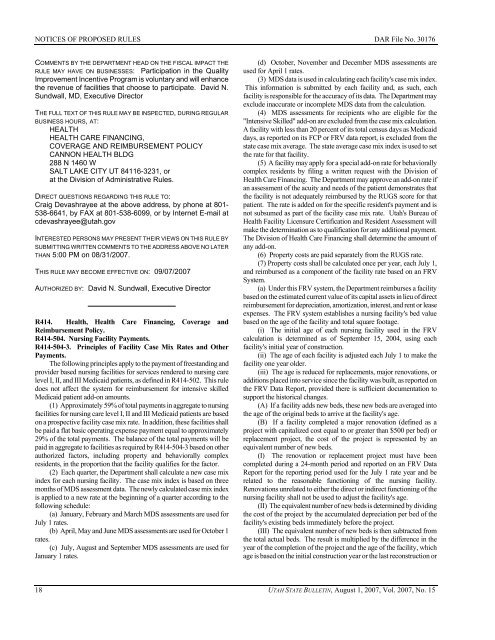

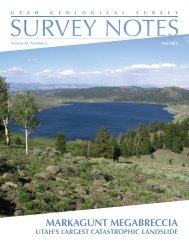
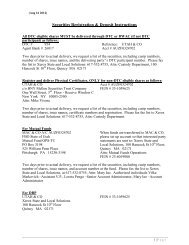
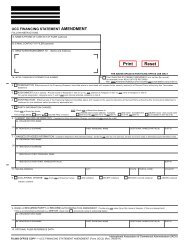
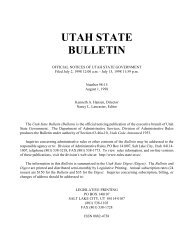
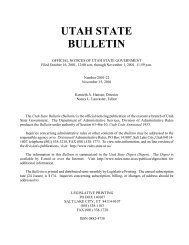



![Lynx avoidance [PDF] - Wisconsin Department of Natural Resources](https://img.yumpu.com/41279089/1/159x260/lynx-avoidance-pdf-wisconsin-department-of-natural-resources.jpg?quality=85)
